 Yamaha announces the much anticipated release of the all-new 2008 model YZF-R6 supersports bike. Full details and pictures.
Yamaha announces the much anticipated release of the all-new 2008 model YZF-R6 supersports bike. Full details and pictures.
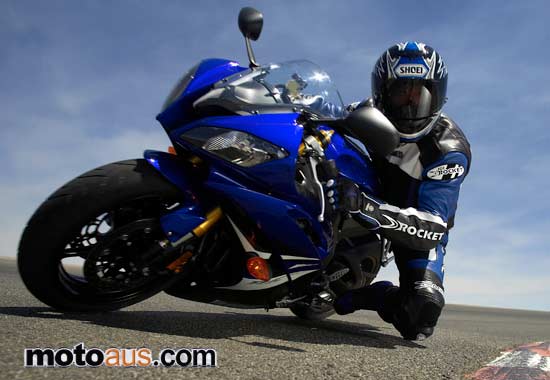
Click for a wallpaper size 1920×1020 of the 2008 Yamaha R6
Yamaha announces the much anticipated release of the all-new 2008 model YZF-R6 supersports bike. This is the bike that has dominated Australian road racing over the last two years, with current champion Jason O’Halloran leading the R6 charge on the high tech 600cc Yamaha Race Team bike.
Even though the new R6 bristles with innovative technology, including even more linear power thanks to variable inlet tracts (YCC-I) and a new Deltabox chassis, YMA has listed this model at just $15,499, an incredible $300 cheaper than the 2007 YZF-R6.
Featuring the most advance race-bred technology ever seen in the 600 supersport class, this sensational new model raises the bar higher by offering unrivalled excitement and class-leading engine and chassis performance. And with its all-new bodywork, the 2008 Yamaha R6 is ready to underline its position as the most impressive, aggressive and high-tech 600 in the class. The 2007 model R6 engine delivers the most incredible hit of power from 10,000rpm upwards.
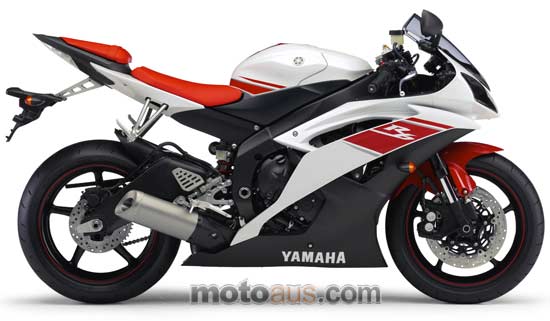
With its class-leading YCC-T (Yamaha Chip-Controlled Throttle), free-revving short-stroke configuration, race-developed fuel injection with secondary injectors, and a torque-boosting EXUP system, the 600cc 4-stroke DOHC in-line 4-cylinder 4-valve powerplant is in a class of its own. For 2008 Yamaha’s engineers have succeeded in increasing the optimum performance potential of the R6 engine to an even higher level, through the application of advanced new technology as well as by fine-tuning a large number of existing components.
The YCC-I system made its highly successful debut on the 2007 model YZF-R1, and for the 2008 season Yamaha have further increased the performance on the latest R6 with the application of this high-tech intake system. The sophisticated YCC-I system consists of four lightweight plastic resin funnels, and each of these is divided into an upper and lower portion which form a single funnel when in normal use. However, when the ECU detects that the R6 engine speed exceeds a specific rpm, and that the throttle opening is also above a specific level, the funnel portions separate so that the shorter lower part functions as an intake funnel, making the longer upper funnel redundant.
The actual movement of the funnels is performed instantaneously by an electrically controlled servo-motor which handles the function so smoothly that the rider is unaware it is happening. And because the actual YCC-I components are light, compact and relatively simple, the whole system is effective and reliable, and is maintenance-free. The new YCC-I system works with the existing YCC-T (Yamaha Chip-Controlled Throttle) to optimise the effectiveness of the fuel injection system and deliver an incredibly precise volume of fuel/air mix to this high performance engine. The remarkable degree of control achieved by the R6’s intake system gives improved low to mid-range torque, and also enhances the power feeling in the higher rpm band. In effect, the YCC-I and YCC-T work together to expand the engine’s power band, making the 2008 model R6 an even stronger and more exciting performer, offering higher levels of easier-to-use power right across the rev range.
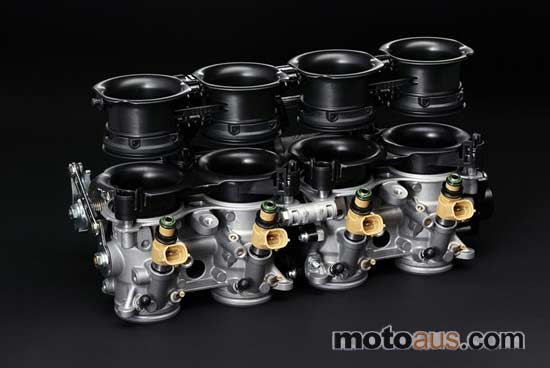
The YCC-T electronic throttle featured on the 2007 R6 delivers outstanding response right across the rev range, from idle through to the red line, and has been hailed as a great success. In order to handle the latest engine’s increased performance ? as well as to compensate for the stronger engine braking effect resulting from the higher compression pistons ? the settings for the YCC-T and fuel injection system have been revised. In addition, a software revision has been made to the throttle actuator for improved response. These subtle changes to the YCC-T and fuel injection settings are designed to improve the engine?s overall operability during acceleration, deceleration and corner entry, giving even more exhilarating performance and extreme excitement, particularly on twisty roads.
Every effort has been made to ensure that the R6 is ready to offer unrivalled performance for 2008, and the latest model benefits from newly-designed pistons that give a higher compression ratio of 13.1:1 compared with 12.8:1 on the 2007 model. The new high-compression piston design features a crown with a slightly convex shape to create a pent-roof type combustion chamber, and the valve recesses are made shallower to accommodate the engine’s four ultra-light titanium valves. 13.1:1 represents the highest compression ratio ever used on a production Yamaha motorcycle, and to handle the increased loads created by the new pistons a number of other changes have been made to the 2008 engine.

The con-rod bearings are wider, while the main bearings feature a revised oil supply hole ? and the intake/exhaust valve springs are made from a higher-strength alloy which ensures effective valve operation for consistently high levels of power during extreme circuit riding. The other significant changes designed to complement the new high compression pistons involve the cam chain tensioner, which is given a palladium carbide treatment to harden its surface for more stable cam chain performance. Finally, the mutual balance between the hydraulic tensioner and spring rate is modified in order to reduce frictional losses for increased performance. To ensure strong torque characteristics the 2007 R6 features a connecting pipe between the second and third cylinder exhaust pipes which induces an exhaust pulse effect every 360 degrees of crank revolution.
To optimise the power-boosting effects of the range of new technology featured of the latest engine, the 2008 R6 exhaust is equipped with a 30% larger diameter connecting pipe which is designed to further improve the bike’s torque characteristics at higher rpm. To maximise the performance gains offered by the increased compression ratio and new YCC-I, the ’08 R6 is fitted with a new airbox design which features a more efficient intake mouth for reduced airflow resistance and better cylinder-filling properties.
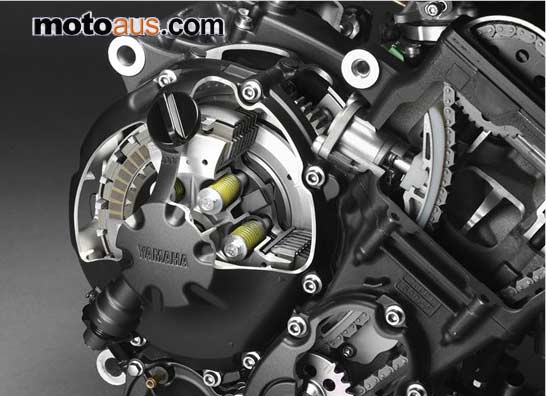
Taking chassis performance to a new level With its lightweight Deltabox frame, long truss-type swinging arm, 52.5% front wheel weight bias, high quality suspension and aggressive mass-forward styling, the third generation R6 was far ahead of its time when it was launched for the 2006 season. The press and public agreed that this truly was a remarkable motorcycle, and the current model R6 is still regarded by many as the ultimate expression of extreme riding excitement. In the same way that our designers have optimised the engine performance by enhancing individual aspects of the original design, so too has the level of chassis performance been raised by making a series of subtle but influential improvements to a wide range of components.
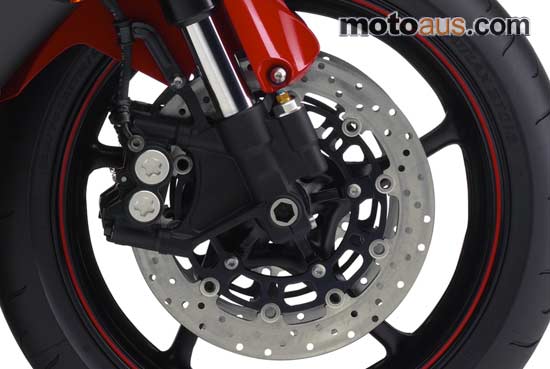
For 2008 our development team have succeeded in elevating the chassis performance to an even higher level with a range of improvements that are designed to deliver razor-sharp handling performance. As a result the 2008 R6 responds instantly and precisely to every steering input, allowing the rider to stick accurately to a chosen line, or to make an instant change at will to suit the conditions. Indeed, to ride the latest R6 is to experience the most impressive levels of braking and cornering performance imaginable from a street-legal machine.
The goal for our designers for 2008 was clear: to create a chassis that would offer a whole new level of handling performance to complement the new YCC-I equipped engine. In order to achieve this, the R6 development team completely re-configured the existing frame?s subtle balance of rigidity by making extremely small changes to the wall thickness on the twin spars, particularly around the knee-grip area. At the same time the wall thickness of the head pipe has been increased for higher levels of rigidity, while the cross-member between the left and right sides of the Deltabox frame is removed for 2008 ? as with the 2007 model R1.
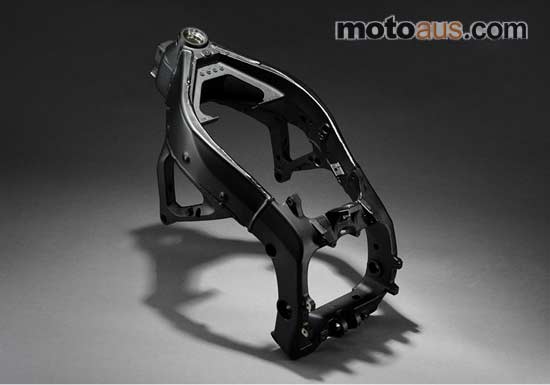
These detail changes – which are virtually impossible to detect from a visual inspection of the exterior – are designed to enhance the rigidity balance between the head pipe and pivot, while also delivering slightly higher levels of lateral flex. The new frame’s revised balance of rigidity and strength has the effect of achieving better handling performance and more precise feel in fast turns, allowing the rider to accelerate harder after clipping the apex. In order to complement the revised handling characteristics of the new Deltabox frame, the fully-adjustable 41mm upside-down forks are equipped with new outer tubes whose rigidity balance has also been altered.
The rigidity balance of the lower aluminium triple clamp has also been adjusted to match the new fork outer tubes and frame. This has been achieved by increasing the width of the fork clamps and redesigning the ribs on the underside of the clamp – and at the same time, fork offset has been increased. The positive effect of these small but important changes to the front end is to give the front tyre an even more “planted” feel during braking and cornering for increased stability, and to enable the rider to feel even more accurate feedback.

The 2008 R6 is equipped with a lightweight magnesium alloy subframe – the first time this material has ever been used for this purpose on a Yamaha motorcycle. Magnesium has an outstanding weight-to-strength ratio, and by saving 450g, this new subframe not only makes an important contribution to reducing overall weight, but also helps to achieve a greater concentration of mass which enhances overall handling qualities. One of the significant features which makes an important contribution to the R6’s remarkable handling agility and stability is its long truss-type swinging arm which pivots close to the bike’s midway point for reduced squat during acceleration.
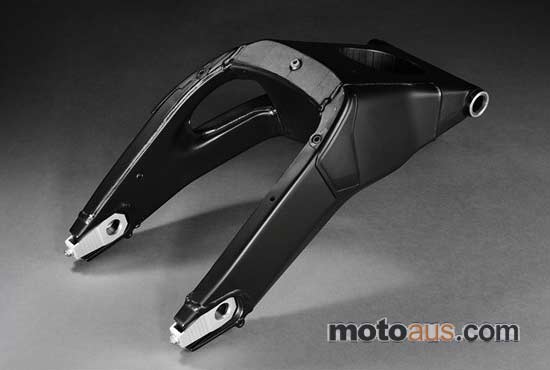
As with the new frame and modified forks, the rigidity balance of this advanced swinging arm has been fine-tuned for 2008 by the addition of ribs inside the rear cast portion – while the end sections have been changed from extruded to forged aluminium. For 2008 the thickness of the dual 310mm diameter front discs has been increased from 4.5mm to 5.0mm, a change which not only improves the heat dissipation qualities during extended use, but also optimises the gyroscopic moment of the front wheel assembly to give a more “planted” feel to the front tyre. To help minimise weight, the rear suspension system’s 2-way compression damping adjuster is mounted on a new lightweight bracket similar to that used on the latest R1.
The R6 features a front wheel weight bias of 52.5%, and to optimise the potential chassis performance our design team have adjusted the riding position to give an even greater overall front end weight bias with the rider on board. The hip position is moved forward by 5mm, and the handlebars are 5mm further forward and 5mm lower, while the angle and drop of the bars is also revised. These changes give the R6 rider a closer and more connected relationship with the bike’s front end, allowing them to interpret more accurately the feedback from the surface.
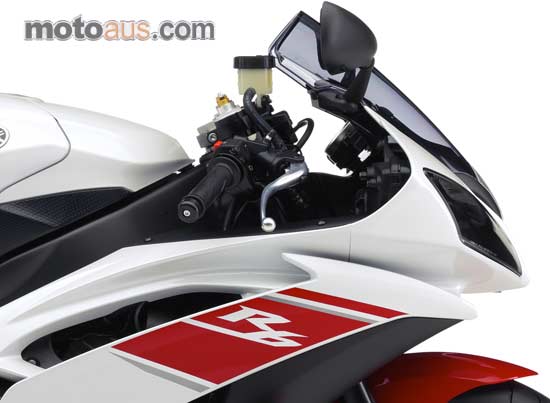
This allows riders to select and hold the desired line through a curve for quicker and more accurate cornering, which gives a more exciting and satisfying riding experience. The third generation R6 broke new ground with its aggressive, cut-down bodywork which gave the impression of a powerful creature waiting to pounce on its prey. Whilst maintaining the essence of the current bike’s special character, the radical new 2008 R6 bodywork design takes this concept to the extreme. The upward bounding motion created by the strong single line running between the rear axle, through the pivot point, and on up to the head pipe is maintained.
For ’08 the upper edges of the sidepanels and the top of the fuel tank have been redesigned to accentuate the mass-forward appearance and focus attention on the front end. The dynamic front cowl is also new, and gives an even more slippery and more aerodynamic look, and is complemented by a new super-slim 4-piece tail cowling. And for reduced drag – and to facilitate removal for track day use – the mirror mounts are relocated from the actual front cowl surface to the cowl brackets.
New 2008 R6 engine features:
Addition of YCC-I electronically-controlled variable intake funnels
Yamaha Chip-Controlled Intake
New high-compression 13.1:1 pistons (?07 model = 12.8:1)
Revised settings for YCC-T and fuel injection
New shape airbox
Uprated con-rod bearings and valve springs
Modified semi-hydraulic cam chain tensioner
30% larger diameter torque-boosting exhaust connector pipe
Reshaped rear muffler section
Engine technical overview:
4-stroke liquid-cooled DOHC 600cc in-line 4-cylinder 4-valve
Bore x stroke 67 x 42.5mm
Maximum power 135bhp at 14,500 rpm with direct air intake
Equivalent to over 200bhp per litre
Yamaha Chip-Controlled Throttle (YCC-T)
Slipper clutch
Titanium EXUP
Exhaust Ultimate Powervalve
Air Intake System with straight induction
Lightweight titanium inlet and exhaust valves
Aluminium valve retainers
Magnesium head and crankcase covers
Close ratio 6-speed transmission
Compact 3-axis shaft layout
Race-developed fuel injection system with secondary injector
Titanium midship muffler with O2 sensor
Compact rare-earth type AC magneto
New 2008 R6 chassis features:
Newly-designed Deltabox frame with revised strength and rigidity balance
Modified front fork outer tubes and lower triple clamp
Revised fork offset Lightweight magnesium subframe
Lightweight rear suspension compression adjuster bracket
New swinging arm with rebalanced strength and rigidity relationship
Lower and more forward riding position
Thicker front disc brakes (?08=5mm; ?07=4.5mm)
Redesigned minimalist mass-forward bodywork Chassis technical overview
‘Straight frame’ Deltabox concept, with steering head, swinging arm pivot and rear axle on one plane
Fully-adjustable 41mm upside-down forks with 2-way compression damping
Fully-adjustable rear shock absorber with 2-way compression damping
Dual 310mm diameter front discs with radial mount calipers
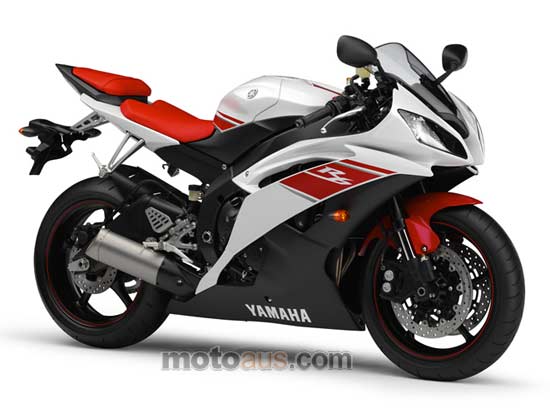
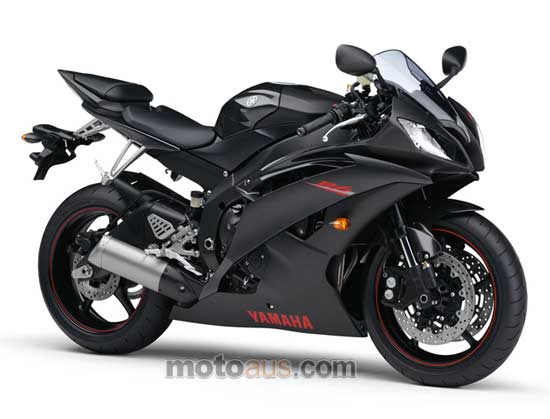
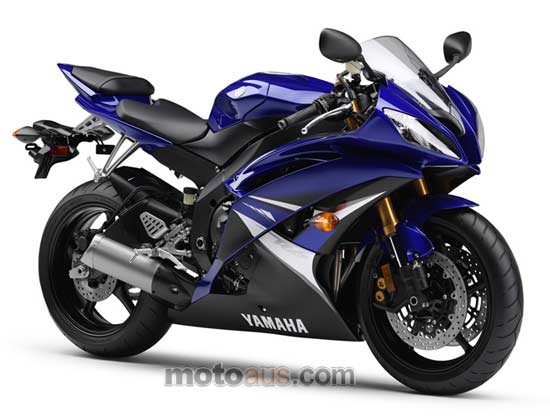
|
|||
| ENGINE/IGNITION/TRANSMISSION | |||
| Type | Liquid-cooled, 4-stroke, DOHC, 4-valve, parallel four | ||
| Displacement – (cc) | 599 | ||
| Bore Stroke – (mm) | 67 x 42.5 | ||
| Compression | 13.1:1 | ||
| Lubrication | Wet sump | ||
| Fuel Management | Electronic fuel injection | ||
| Ignition | TCI | ||
| Starter | Electric | ||
| Fueltank – (L) | 17.3 | ||
| Oil Capacity – (L) | 3.4 | ||
| Transmission | 6-speed w/ slipper clutch | ||
| Final Transmission | Chain drive | ||
| CHASSIS | |||
| Length – (mm) | 2040 | ||
| Width – (mm) | 700 | ||
| Height – (mm) | 1100 | ||
| Seat Height – (mm) | 850 | ||
| Wheelbase – (mm) | 1380 | ||
| Clearance – (mm) | 130 | ||
| Dry Weight – (kg) | 162 | ||
| FRONT END | |||
| Suspension Front | USD fork, 115mm travel | ||
| Tyres Front | 120/70 ZR17MC (58W) | ||
| Brakes Front | Four Piston radially mounted twin 310mm discs | ||
| REAR END | |||
| Suspension Rear | Monocross, 120mm travel | ||
| Tyres Rear | 180/55 ZR17M/C (73W) | ||
| Brakes Rear | Single 220mm disc | ||
